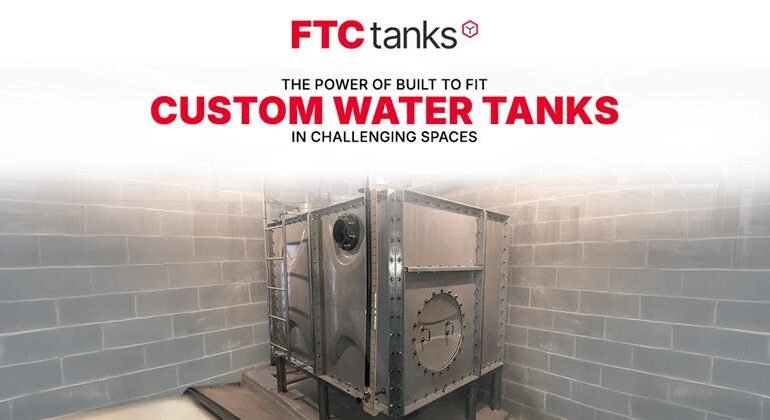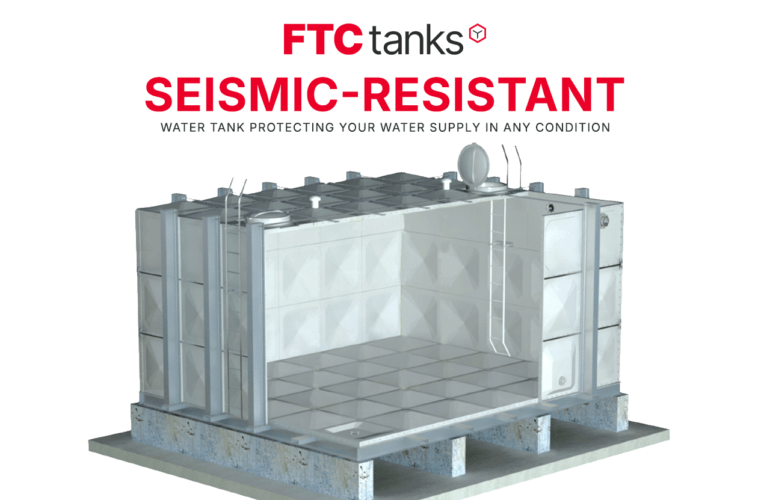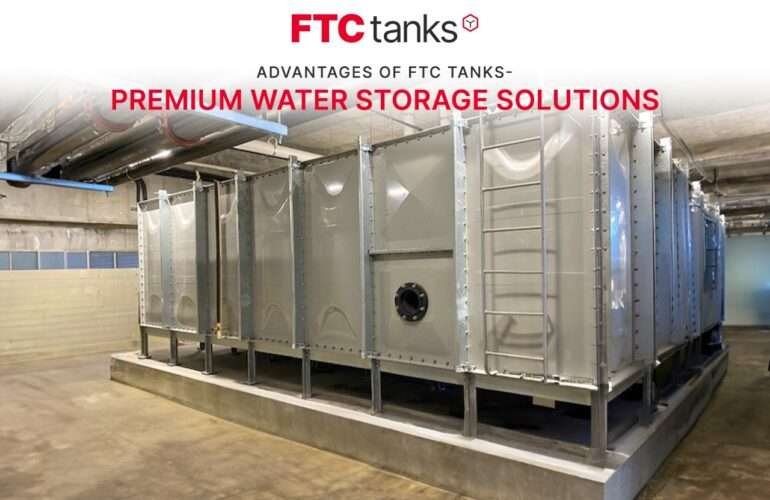Old water cisterns once did their job quietly and well. They collected rain, stored clean water, and kept homes and buildings running without trouble. But time changes everything. Inside those tanks, rust spreads, cracks grow, and water quality starts to drop.
What once felt reliable is now risky. Many old systems allow bacteria to thrive and chemicals to leach into the supply. These hidden problems can turn simple water storage into a health concern.
Today, modern infrastructure depends on safety and consistency. That’s why engineers and facility managers are turning to FRP water tanks and NSF-certified water tanks. These systems protect water purity and last for decades with little upkeep. Understanding how older tanks fail is the key to preventing contamination and ensuring every drop stays clean.
What Happens Inside an Aging Cistern
Step inside an old cistern, and you’ll see how time takes its toll. Metal tanks rust from the inside out. Concrete ones begin to crack and crumble. Once this happens, air, bacteria, and debris sneak in. Sediment collects at the bottom, trapping moisture and feeding microbial growth.
Without cleaning or inspection, stored water loses its clarity and safety. The system that once supplied fresh water has now become part of the problem.
Here’s a closer look at what typically goes wrong inside old water storage tanks:
| Problem | Cause | Impact |
| Corrosion | Metal oxidation | Rust, leaks, contamination |
| Cracks | Concrete fatigue | Bacterial ingress, loss of pressure |
| Biofilm buildup | Stagnant water | Microbial contamination |
| Sediment accumulation | Lack of filtration | Water discoloration, odor |
Each issue might start small, but together they can ruin the entire system. A neglected tank doesn’t just store water — it stores risk.
The Invisible Threats
The worst damage often goes unseen. Inside old water cisterns, bacteria and chemicals can quietly build up over time.
- Microbial growth: Stagnant water becomes a home for E. coli and Legionella. Once they spread through supply lines, they can cause serious health problems.
- Chemical leaching: Aging coatings or linings release harmful substances that affect water safety.
- Thermal instability: Weak insulation lets temperatures rise and fall, creating ideal conditions for bacteria.
These aren’t distant problems; they happen in tanks still in daily use. A single overlooked cistern can put an entire building at risk. Regular testing, cleaning, and upgrades aren’t just maintenance; they’re protection.
Health & Safety Concerns from Outdated Tanks
Every old water cistern holds a story, but not all end well. What once stored fresh, clean water can now quietly breed problems. Aging tanks lose their integrity, inviting rust, bacteria, and unseen toxins.
Let’s explore how these outdated systems endanger both safety and peace of mind.
Contaminated Drinking Water
When a water storage tank grows old, it doesn’t just look tired. It begins to poison what it’s meant to protect. Inside, layers of rust, dirt, and decaying coatings mix with the water.
Bacteria like Legionella and E. coli love these conditions. They multiply fast, spreading through every tap and pipe they can reach. Add in heavy metals or sediment, and the result is unsafe drinking water. Families, workers, and even industrial operations can fall victim to something that started with a few unnoticed cracks.
NSF-certified water tanks are built to stop this chain of risk. They use non-toxic materials and follow strict production standards. Every layer of these tanks protects your water from contamination, giving you safe, clear water every single day.
Fire Safety at Risk
Imagine a fire breaking out and the cistern refusing to deliver. It’s not just bad luck. It’s often because the tank couldn’t handle the pressure when it mattered most.
Old or undersized cistern can fail under heavy demand. Corrosion, leaks, or weak seals can turn a small emergency into a full-blown disaster. Modern FRP tanks are designed for these moments. They hold strong, resist heat, and deliver steady water flow.
Tanks that meet NFPA water tank standards offer something priceless — reliability when lives and property are on the line. In a crisis, every second counts. A tank that performs without hesitation can make all the difference.
The Cost of Neglect
Fixing an old water cistern might sound practical at first. But as the years pass, those patches turn into a cycle of stress and spending. The truth is simple. Old tanks don’t age gracefully, and the hidden costs pile up fast.
Let’s look at what happens when short-term repairs replace long-term solutions.
Short-Term Repairs vs. Long-Term Replacement
Quick fixes might seem budget-friendly, but they rarely solve the real issue. Old water storage tanks suffer from deep structural damage that keeps spreading beneath the surface.
Each repair hides a bigger problem waiting to return. The result? More leaks, more contamination, and more wasted money.
Here’s what neglect can lead to:
- Leaks that waste thousands of gallons each year.
- Bacteria buildup that demands costly treatment.
- Failed safety checks that bring fines or shutdowns.
Switching to durable FRP tanks ends that cycle. They last longer, need less upkeep, and protect both your water and your wallet.
Real-World Consequences
Consider a commercial complex that ignored its aging water cistern for years. One morning, residents noticed brown water flowing from their taps. Tests revealed bacterial contamination. The management faced heavy fines, urgent replacement costs, and weeks of public complaints.
Why FRP Water Tanks Offer a Safer Future
Old cisterns belong to another time. Today’s needs call for smarter materials that stand strong against the elements. The future of safe, sustainable water storage lies in innovation — and that’s where FRP tanks lead the way.
Superior Material
The secret behind every FRP water tank is simple science done right. Made from Fiberglass Reinforced Polyester, these tanks don’t rust, corrode, or crumble like concrete or steel. Instead, they combine strength with flexibility, lasting decades with barely a sign of wear.
Their non-porous walls keep bacteria and algae from settling in. Every layer is designed to handle stress (chemical, thermal, or environmental) without losing shape or integrity. The result? Reliable water storage that stays clean, safe, and strong year after year.
Key Advantages:
- Non-porous interior prevents microbial growth.
- Resistant to UV, and thermal stress.
- Lightweight structure reduces installation cost and energy.
When strength meets simplicity, you get performance built for the long run. That’s what makes FRP tanks a smart, lasting investment.
Designed for Modern Standards
Safety and sustainability aren’t optional anymore — they’re expected. Every FRP water tank is built to meet the world’s strictest quality benchmarks.
NSF-certified water tanks guarantee that the water you drink is free from harmful substances. NFPA water tank standards ensure that during an emergency, water is ready when fire crews need it most. And with LEED-friendly materials, these tanks also support eco-conscious construction practices.
Whether it’s an industrial complex or a city’s backup fire water tank, FRP technology adapts beautifully. The same tank that stores potable water today can safeguard lives tomorrow. It’s the kind of versatility that keeps modern infrastructure one step ahead.
Transitioning to Modern Water Storage Solutions
Upgrading an aging cistern doesn’t have to be complicated. With the right plan and partners, the transition to FRP water tanks is smooth, safe, and surprisingly quick.
Steps for Safe Replacement
The shift begins with a careful look at what’s already in place. Facilities can assess tank structure, check water quality, and design a clear replacement plan that minimizes downtime.
Simple steps to follow:
- Inspect structural integrity and test water quality.
- Choose NSF61, NSF372 and NFPA22 certified & compliant tank models.
- Partner with certified installers for compliance assurance.
Each step builds a safer, cleaner future for your water storage systems — one that’s designed to last for decades, not years.
Maintenance Best Practices
Here’s how modern FRP water tanks outshine their aging counterparts in daily upkeep:
| Aspect | Old Concrete/Metal Tank | FRP Water Tank |
| Corrosion Resistance | Low | High |
| Cleaning Frequency | Frequent | Minimal |
| Lifespan w/ no Maintenance | 10–15 years | 40+ years |
| Water Quality | Variable | Stable & safe |
With their smooth interiors and strong outer layers, FRP tanks make maintenance easy. Less cleaning. Fewer repairs. Better water quality. It’s a small change that delivers big peace of mind.
The Bottom Line
Old cisterns once kept things running smoothly. Today, they carry hidden risks — corrosion, leaks, and contamination that quietly grow worse with time. Modern systems need storage that’s clean, compliant, and built to last.
That’s why so many facilities are shifting to FRP water tanks. They stay strong under pressure, meet NFPA water tank standards, and keep potable water pure. Simple, efficient, and reliable — everything that old systems no longer offer.
If your tank has seen better days, upgrading isn’t just smart; it’s safe. Clean water deserves solid protection, and the right tank makes all the difference.Clean water shouldn’t be a gamble. Partner with FTC Tanks for dependable FRP water tanks built to perform, protect, and last.





